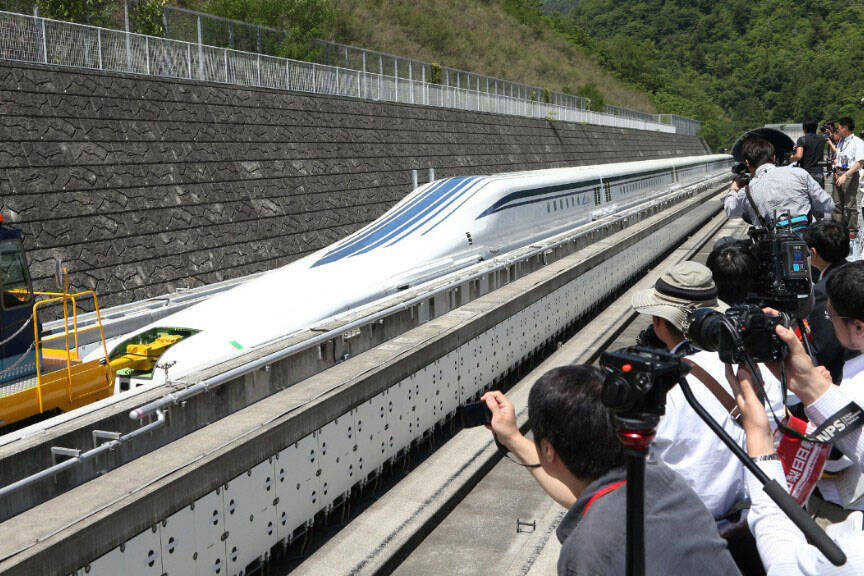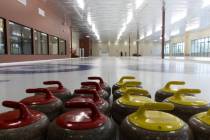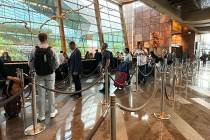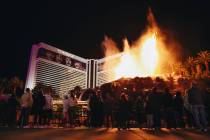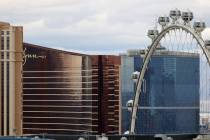Before the LV-to LA rail project, maglev was planned
People driving to and from California this and last week may have seen work crews in the Interstate 15 median and on some highway shoulders surveying the landscape and taking core samples.
It’s the initial work for the $12 billion Brightline West high-speed rail line being built between Las Vegas and Southern California.
And it’s about time.
People have been talking about connecting Southern Nevada with its largest tourism market for more than five decades. It’s been so long that many people aren’t even familiar with the most revised proposal and others who thought a train to and from SoCal would never happen are still convinced it never will.
For those new to the area or unaware of the difficulties getting to where we are now, here’s a short history of what you’ve missed.
Back in the 1970s, people began talking about a new transportation system in development called “magnetic levitation,” or maglev for short. Instead of the traditional steel wheels-on-rails, engine-propelled trains, maglevs floated inches above a magnetically charged guideway system with vehicles moved by the opposing forces of magnets.
Proponents believed an L.A.-to-Vegas maglev line was a perfect way to bring the new technology to the United States because visitors to Las Vegas would be fascinated to travel in vehicles that were silent and frictionless and capable of safely traveling more than 350 mph.
The innovative transit mode was seen as a perfect match for our city and consultants and investors lined up support along a transportation corridor that extended from Los Angeles to Las Vegas.
Among the early backers was Sen. Harry Reid — the same guy our airport is named for — who saw maglev as a good fit and he supported and encouraged it.
Meanwhile, a competitive group that favored traditional rail began questioning maglev’s viability.
But Reid remained patient — for a while.
Reid, a former Nevada lieutenant governor and Nevada Gaming Commission chairman, understood the value of a groundbreaking technology that benefited tourism. He was elected to the U.S. Senate in 1987 after two terms in the U.S. House, and in that role, he was able to assist the maglev effort.
But by 2010, Reid could support it no more.
Reid complained that maglev had three decades to prove itself and that it was time to move on to the more conventional high-speed rail advocated by a company then known as DesertXpress.
“I have no ill will toward the people behind the maglev project and want it to be clear that no one, including me, is stopping them from moving ahead with their project,” Reid said at the time. “During the many years I supported maglev, Congress made more than $50 million available, including a $45 million appropriation in 2008. We are now well into 2010 and maglev has failed to come up with the 20 percent match needed to obtain these federal funds, which is why I reprogrammed the $45 million for a transportation project in Southern Nevada that will actually create jobs right away,” he said.
“While Nevadans are rightfully impressed with the maglev technology, they, like me, just want to see something get done. DesertXpress is ready to break ground and put Nevadans back to work this year.”
But, as everyone knows, that never happened.
In December, the Nevada Department of Transportation, in partnership with Brightline West, was awarded $3 billion from the U.S. Department of Transportation toward the system. The 218-mile, all-electric high-speed rail service would include a flagship station in Las Vegas, with additional stations in Apple Valley, Hesperia, and Rancho Cucamonga, Calif. At 186-plus mph, trains will take passengers from Las Vegas to Rancho Cucamonga, where commuter rail can be used to get to Los Angeles, in two hours and 10 minutes, twice as fast as the average drive time.
Brightline West plans to break ground this year with an ambitious schedule of being open in time for the Los Angeles Summer Olympic Games in 2028.
It’ll also whisk hundreds of thousands of people to Las Vegas, taking thousands of cars off I-15.
Contact Richard N. Velotta at rvelotta@reviewjournal.com or 702-477-3893. Follow @RickVelotta on X.




